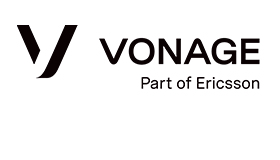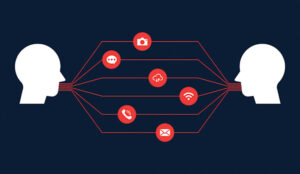Chris Mina at Vonage explores how if your organization is looking to improve communication and collaboration and enhance the customer and employee experience, chances are you’re considering unified communications as a service (UCaaS) and contact centre as a service (CCaaS).
It’s natural to focus on the difference between UCaas and CCaaS. They’re generally used by different departments and for different overall purposes. But the two tools actually have similar functionalities. Instead of thinking of UCaaS vs. CCaaS as a competition, consider them as complementary.
What is UCaaS?
UCaaS stands for Unified Communications as a Service.
UCaaS consolidates a company’s enterprise communications applications (including voice, video, messaging, and conferencing) into a single cloud-based platform.
It provides your people with the collaboration tools to work anywhere by functioning across computers, desk phones, and smartphones.
The solutions are designed to support mobility and interoffice collaboration with features like call routing and forwarding, conference bridging, virtual receptionist, and voicemail-to-email transcription.
How Does UCaaS Work, and What Does It Do?
UCaaS’s primary benefit comes from its ability to intertwine various types of digital communications into a single space.
For example, a UCaaS platform could allow a sales representative to have the same phone number at their desk and on mobile, feed their voicemails as text to their email inbox, and allow them to make video conference calls from their company’s platform of choice.
UCaaS platforms do this in part through the propagation of application programming interfaces (APIs), which allow companies to take bits and pieces of the communications functionality they need and build them directly into systems they utilize.
Grouping digital communications into a single space allows for better integration with existing business processes. With interlinked solutions, companies can use UCaaS to break down silos and can even dig into the data their platforms generate to further optimize service and productivity.
What Are Some Benefits of Using UCaaS?
Many of the benefits of UCaaS tie directly to the technology’s ability to help people work together — and it can benefit organizations regardless of size:
- Facilitating greater workforce mobility
- Promoting greater cross-department collaboration and reducing silos
- Improving productivity
- Providing easier alignment of departmental and organizational goals
What Is CCaaS?
CCaaS also enables multichannel communications via a single cloud-based platform. The big difference between UCaaS and CCaaS is that UCaaS is more about internal collaboration while CCaaS is all about helping businesses connect with their customers and prospects in the channels they want to meet in.
A CCaaS solution offers businesses features like skills-based routing, customer authentication, AI-powered voice analysis, and split recording — tools organizations use to provide customer-facing services and features.
As with UCaaS, CCaaS combines advanced features like these and puts them in a central place. This gives businesses the ability to grow their customer outreach and service far faster than if they were to build or implement individual components on their own.
How Does CCaaS Work, and What Does It Do?
CCaaS works by enabling several powerful communication and customer service and contact tools at scale and with great speed.
This may include features like instantaneous call routing, interactive IVRs, APIs for features like video calling, and more. CCaaS platforms also include powerful self-service tools that companies can build directly into their customer-facing interactions with a minimum of expense or hassle.
As with UCaaS, CCaaS allows for stronger, smarter, more thorough data analysis. For example, a contact centre manager could use a built-in dashboard to monitor KPIs (key performance indicators) such as call length, handoff time, customer satisfaction, and more — and use the same platform to capture calls for later analysis. They could even listen to a call live.
What Are Some Benefits of Using CCaaS?
Understanding the path of evolving customer tastes helps underscore the value of CCaaS. Customers have increasingly turned to digital channels in the past several years, and their expectations for low-friction interactions have perhaps never been higher.
When they get caught in voice-response loops or have to struggle to find a human, they are more likely to abandon a company.
That’s why it’s important to think like customers and consider issues that may frustrate them. These include long hold times, having to repeat the issue, or multiple call transfers.
And this is where CRM integrations — including Salesforce, Microsoft Teams, ServiceNow, and more — come into play, allowing contact centre agents to do things like quickly glance at records for historical context to better address customers before a call.
For companies concerned about the customer experience, CCaaS and its benefits become obvious. Using CCaaS can lead to happier customers, faster responses, better promoter scores, and other related KPIs, as well as an overall better contact centre experience. That starts with having lower wait times and continues with giving highly personalized service.
UCaaS and CCaaS: A Quick Comparison
| UCaaS | CCaaS | |
|---|---|---|
| Primary Use | Improving communication between employees and departments by combining and empowering communications tools | Improving promoter scores and overall customer satisfaction with tools that make for easier, higher-value customer contacts everywhere they interact |
| Use Settings | Office buildings, home and remote workspaces, and everywhere else employees interact digitally | Customer contact centers, sales divisions, and wherever in- and out-bound customer contact is a major part of the job |
| Customer contact centers, sales divisions, and wherever in- and out-bound customer contact is a major part of the job | Consolidated internal voice, video, and messaging across devices, enabling call routing, conference bridging, voicemail-to-email transfer, and more | Consolidated customer contact channels across devices, simplifying customer authentication, service routing, voice analysis, and more |
They’re Better When Bundled Together
Office employees, contact centre staff, remote sales agents, and other arms of the business that rely on effective communication and collaboration to get the job done may not always interact with each other — but the tools they use definitely should.
When they bundle UCaaS and CCaaS, organizations get the best of both tools from a single cloud-hosted partner. This results in fewer expensive hardware installations (or perhaps even none), a single point of contact for billing, and one point of contact to turn to if questions arise.
Let’s take a look at five benefits businesses can achieve when they bundle UCaaS and CCaaS:
1. Stronger Office and Contact Centre Collaboration
In some cases, contact centres might collaborate directly with internal departments — such as outbound marketing callers who pass warm leads along to inside sales. Other contact centres may be mostly self-sufficient, but might occasionally need insights and information from other employees.
Say a customer calls into a contact centre with a product question the agent can’t answer. The agent can view a company directory in UCaaS, check employee statuses to see who’s available in the manufacturing department, start a chat with that internal expert, and get instant answers.
If the answers are complicated and require further discussion, the agent can route the customer directly to the expert’s phone.
2. Better Customer Experience
Most people who reach out to a business don’t know (or care) whether they’re talking to someone in a corporate office or a contact centre.
They still expect fast service and a seamless customer experience. They don’t want to be asked to identify themselves repeatedly or told to call a different number. Yet that’s what happens when office employees and contact centre agents can’t communicate in real time or route calls to one another.
Consider a client who needs tech support and calls the salesperson who sold them the product. Instead of giving the customer the tech support number, the salesperson can reach out directly to the contact centre team, tee up the conversation, ensure someone is ready to help, and then loop the customer into the call.
UCaaS/CCaaS integration is particularly useful in industries or functions where callers must be authenticated and interactions are recorded and logged for compliance. When the two systems are integrated, callers only need to be authenticated once, even if they’re routed from one location to another.
3. Optimized CRM Integration
Leading unified communications platforms are designed to integrate with CRM (customer relationship management) applications like Salesforce, enabling features like click-to-dial and automatic call logging.
While logged into UCaaS, users can see screen pops identifying incoming callers, complete with customer data from the CRM system. They can also be prompted to enter notes about each customer interaction, which also gets logged in CRM records.
By integrating CCaaS and UCaaS, contact centre agents get the same functionality. As a result, the CRM system stays up to date, and teams across locations and functions can share data about customer interactions — no toggling or multiple logins required.
4. Integrated Data
Business leaders have been hearing for years that they need to break down silos and consolidate data. Consolidating communications is a great start.
In the short term, integrated communications data means teams across departments and functions are on the same page. Long term, it means being able to leverage sophisticated data analytics tools, internet of things (IoT) automation, and artificial intelligence algorithms.
5. Reduced Cost of Communications
Individually, UCaaS and CCaaS reduce communications costs by providing one-stop shops. Rather than piecing together phone service, conferencing solutions, and video applications, businesses get all these services from one platform — or from two connected platforms, as many companies consider UCaaS and CCaaS separate solutions and buy them as such.
By bundling UCaaS and CCaaS, companies get the functionality of both platforms from one cloud-hosted vendor. That means no expensive hardware to install or manage, one bill to pay, and one platform for IT to manage.
This blog post has been re-published by kind permission of Vonage – View the Original Article
For more information about Vonage - visit the Vonage Website
Call Centre Helper is not responsible for the content of these guest blog posts. The opinions expressed in this article are those of the author, and do not necessarily reflect those of Call Centre Helper.
Author: Vonage
Published On: 27th Sep 2022 - Last modified: 29th Sep 2022
Read more about - Guest Blogs, Vonage






 Vonage is redefining business communications, helping enterprises use fully-integrated unified communications, contact centre and programmable communications solutions via APIs.
Vonage is redefining business communications, helping enterprises use fully-integrated unified communications, contact centre and programmable communications solutions via APIs. 










